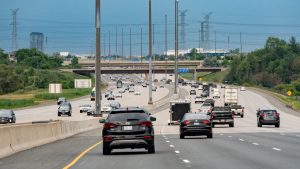The Manitoba government intends to crack down on drivers speeding through construction zones.
The Manitoba government intends to crack down on drivers speeding through construction zones.
Proposed amendments to legislation are in response to the death of a traffic control person three years ago.
“When you enter a construction zone, you are entering someone’s workplace. We want to ensure the safety and protection of construction workers,” said Erna Braun, Manitoba’s labour and immigration minister.
“In addition to this important legislation, Manitoba Workplace Safety and Health will be stepping up enforcement measures to ensure that worker safety standards are maintained at the highest level during construction.”
The temporary speed limit when passing construction zones in Manitoba is 60 kilometres per hour and the current fine for exceeding the limit by 10 kilometres an hour is $181.50.
The proposed amendments to the Highway Traffic Act, which were introduced by Braun on Nov. 15, would impose additional fines of $7.70 for each km/h of excess speed.
This is an increase from the current $5 per km/h for excess speed.
The legislation would also allow for clear signage indicating when reduced limits are in effect, what they are and when they end.
The additional fine would apply whether or not workers are present or equipment is being used in the construction zone.
In addition, legislation would require the use of specified traffic control devices such as barriers, rumble strips and speed readers in construction zones.
The Manitoba government introduced Bill 2 in response to the death of 21-year old Brittany Murray in Oct. 2010.
Murray was struck by a driver travelling at 112km/h through a construction zone.
The vehicle speed was nearly twice the 60km/h speed limit that takes effect when workers are present.
The Manitoba Federation of Labour (MFL) raised serious concerns about the inadequacy of regulations to protect construction workers on road and highway projects, after a decision by a Manitoba Judge in Aug. 2013 to acquit the driver of the vehicle.
Justice Doug Abra decided that 79-year old Mitchell Blostein should be acquitted of dangerous driving causing death.
He said that Murray was flagging at a location that was some distance away from the actual construction work.
The current regulations state that a driver should not exceed 60 km/h, only if there are workers in the immediate location.
“The recent court decision in the Brittany Murray tragedy shows that Manitoba safety rules need to be fixed,” said MFL President Kevin Rebeck, in an open letter sent to the minister of family services and labour Jennifer Howard on Aug. 15.
“The judge in that case said a lack of clarity around when and where drivers need to slow down was a key factor in the acquittal of the driver, whose vehicle killed Murray.”
The letter called on the provincial government to urgently clarify Manitoba’s rules so that drivers know exactly when and where reduced speed limits are in effect for a construction zone.
“The current practice of requiring a reduced speed only when workers are present is problematic because by the time a driver encounters workers on the road, it is often to late to slow down to a safe speed,” said Rebeck.
“Determining whether or not workers are present and a reduced speed limit is in effect should not be left to drivers.”
The letter refers to new rules in neighbouring Saskatchewan that require clear signage, rumble strips and gates to alert drivers that they are entering a construction zone.
Saskatchewan’s new rules also include reduced speed limits.
“Making sure drivers know when and where they need to slow down is the most important lesson we can learn from the Brittany Murray tragedy,” said Rebeck.
“We owe it to her and to all road workers to fix these safety rules.”
The open letter also called for other measures to better protect the safety of road workers, including mandatory controls for employers, such as signage, barriers and workers position.
Rebeck also recommended that the Workplace Safety and Health branch needs to conduct high profile inspection blitzes focused on road worksites.










Recent Comments
comments for this post are closed